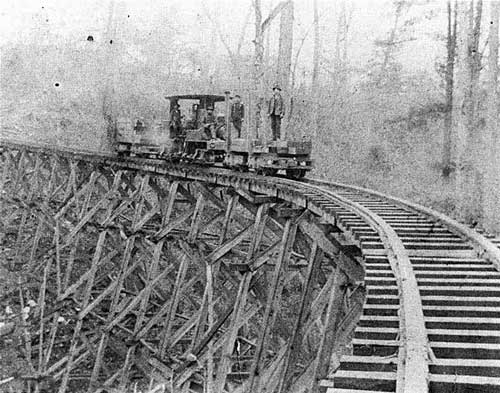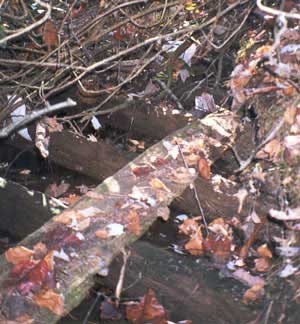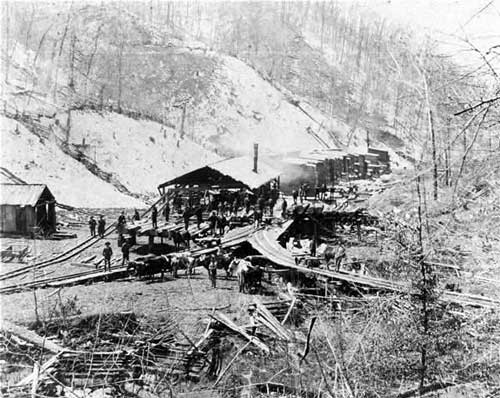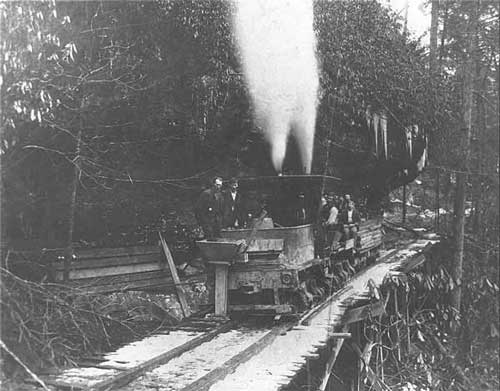D. H. Eastin & Company
Walkers Creek, Lee County, Kentucky
to Eastintown, Wolfe County, Kentucky
36-inch Gauge (Wood Rail)
Eastin & Brothers was a family logging company comprised of five brothers - Augustus C. “Gus” Eastin - Thomas E. Eastin - Dudley H. Eastin - Charles L. “Charlie” Eastin - and Simeon B. “Sim” Eastin. They are known to have been logging along the Red River in Clark County as early as 1888. Lumbermen were always a clever and resourceful group of men and the Eastin brothers were no exception. A newspaper article from the Winchester Democrat, dated April 17, 1889 - originally printed in the Mount Sterling Gazette - relates the following:
“Eastin and Bros., lumbermen of Clark County, near the mouth of Red River, having used up all the logs near them, decided to move their mill to Beattyville. They tried to contract with boatmen to carry it up, but could not arrange with them for less then $150, and they concluded to tie two floats together, put on their machinery, etc., and with their engine so placed on the boat that the drive wheel, with propellers attached, would rest in the water and drive the boats, to carry their own freights. This they did effectively and landed at their destination safely.”
No further mention of the firm of Eastin & Brothers has been found after the move to Lee County in 1889, and it is not until early 1893, that we can again trace their activities. It is apparent that during this period, the Eastin brothers became acquainted with established lumbermen Floyd and J. Taylor Day. Not only would the Eastin brothers work closely with the Day brothers over the next few years, but a friendship also developed. Dudley Eastin had so much respect for Floyd Day that he would name his first son, born October 30, 1894, Floyd Day Eastin.
 A portable circular sawmill used on one of the Eastin brothers operations. (Mrs. Eugene Peck - Ed Vasser Collection)
A portable circular sawmill used on one of the Eastin brothers operations. (Mrs. Eugene Peck - Ed Vasser Collection)By September 1893, Gus Eastin was operating his own portable saw mill and mule-powered tram road at Fincastle, in Lee County. He was apparently producing railroad ties for the Kentucky Tie Company, a partnership of Floyd Day and F. B. Russell. And in this same year, the operations of D. H. Eastin & Company begin to emerge.
D. H. Eastin & Company was a partnership of brothers Dudley, Charlie, Sim and Gus. Thomas does not appear to have been a partner in this operation and may have been working his own small logging operation elsewhere. Another principal figure in this operation was John G. Spencer of Wolfe County, who was the saw mill superintendent.
On November 4, 1893, Gus Eastin had acquired the timber rights to 123 acres of land located on the Smoky Fork and Little Forks of Lower Devils Creek in southwestern Wolfe County. With the nearest rail access 3 miles from their timber tracts; a railroad would have to be constructed between the saw mill site on Lower Devils Creek and over Big Andy Ridge to a point on the Lexington & Eastern Railway on Walkers Creek. A wood rail tram road would be built to save costs, however; financing to build the tram road and acquire a locomotive to power the trains was beyond the means of D. H. Eastin & Company, so they turned to Floyd Day for assistance.
 Photograph taken in 1893 or 1894 by S. E. Vaughan of Campton, during construction of the D. H. Eastin & Company tram-road. (Mrs. Eugene Peck - Ed Vasser Collection)
Photograph taken in 1893 or 1894 by S. E. Vaughan of Campton, during construction of the D. H. Eastin & Company tram-road. (Mrs. Eugene Peck - Ed Vasser Collection)The exact starting date for the Eastintown operation is unknown, but appears to have been in late 1893 or early 1894. Floyd Day purchased a small used 6 ton Lima Shay geared locomotive from a lumber company in Mississippi and had it shipped to Torrent, Kentucky. Arrangements were then made for Gus Eastin to purchase the locomotive for use on their logging operation and construction of the 36 inch narrow gauge wood rail tram road began immediately.
A siding was laid on the Lexington & Eastern Railway in Lee County; about 1 mile south of the Torrent tunnel, and a small circular saw mill and lumber storage yard was established at this point. Shown as Walkers Creek Switch in various documents pertaining to D. H. Eastin & Company; it was established as a station on the Lexington & Eastern Railway named Walkers Creek and appeared in the passenger tariffs of that company as late as 1906.
Techniques used during construction of the tram road were typical of eastern logging railroads. A mixture of cut lumber and logs were used on the trestles. Very little grading was done, so trestlework was abundant. Construction of the wood rail tram road was similar to conventional steel rail and cross tie construction, but had the advantage in that all material, except for spikes, was on hand at no cost. Labor costs however were little cheaper than that of laying steel rail on lightly graded roadbed.
 D. H. Eastin & Company train crossing one of the numerous high trestles along the tram-road. The Shay locomotive is in the middle of the train to allow for doubling the train up steep grades on the wooden rail. Two loaded cars of finished lumber probably taxed the locomotive to its limit on some of the grades. (Mrs. Eugene Peck - Ed Vasser Collection)
D. H. Eastin & Company train crossing one of the numerous high trestles along the tram-road. The Shay locomotive is in the middle of the train to allow for doubling the train up steep grades on the wooden rail. Two loaded cars of finished lumber probably taxed the locomotive to its limit on some of the grades. (Mrs. Eugene Peck - Ed Vasser Collection)Rough-hewn cross ties or small logs where laid on lightly graded roadbed and the wood rails spiked to these ties. The wood rails were composed of two sections of 2 inch by 5 inch hard wood laid on top of each other so that the joints overlapped. These two-piece rails were then spiked to the ties using counter-bored holes to prevent the spike heads from protruding above the surface.
To cross the Big Andy Ridge, two switchbacks were required on the Walkers Creek side with a fairly deep cut at the top of the ridge. Descending into the Lower Devils Creek area, no less than six switchbacks were required to ease the grades. When completed, the tram road was 3 miles in length, and a trip over the line must have been spectacular as the train ran along and under shear over-hanging cliffs and crossed the numerous trestles. Remains of the cut at the top of the ridge can still be seen today, but practically all other traces of the railroad have disappeared. In one location along the abandoned tram road, a small section of the wood rail was discovered while exploring the route. Preserved all these years due to being partially submerged in water.
 A section of wooden rail discovered by Thom Placier and Eugene Peck while exploring the route of the tram-road. (Photograph by Thom Placier)
A section of wooden rail discovered by Thom Placier and Eugene Peck while exploring the route of the tram-road. (Photograph by Thom Placier)The tram road terminated in a narrow valley on Lower Devils Creek in southwestern Wolfe County. At this location a circular saw mill, three stores and over twenty homes were constructed. The little community was named Eastintown and was a beehive of activity during the years that the saw mill remained in operation. All that remains today of this once thriving area are a few stone chimneys of the homes.
 The D. H. Eastin & Company circular sawmill at Eastintown in Wolfe County. Note the use of horses and oxen used on the tram-road. (Mrs. Eugene Peck - Ed Vasser Collection)
The D. H. Eastin & Company circular sawmill at Eastintown in Wolfe County. Note the use of horses and oxen used on the tram-road. (Mrs. Eugene Peck - Ed Vasser Collection)The saw mill had a daily capacity of about 10,000 board/feet of finished lumber, and several narrow gauge wood-railed tram roads radiated out into the timber from the mill. Horses, mules and oxen supplied the power on these tram roads to move the logs to the saw mill. The little Shay locomotive would haul the finished lumber from Eastintown to Walkers Creek, probably making two or more trips per day. Six sets of 4-wheel tram cars or logging trucks were used on the line between Eastintown and Walkers Creek, but photographs never show more then two sets being used on a train. Two loaded sets of the logging trucks were probably all the small locomotive could handle over the steep grades.
Additional tracts of timber were acquired between 1893 and 1895 in the Lower Devils Fork area and along the route of the tram road, but by 1898, all the timber had been logged out. However, the life of the Eastintown operation was extended by a few years when Floyd Day purchased 800 acres of land in the Lower Devils Creek area from the Winchester Bank in February, 1898. D. H. Eastin & Company then logged this land for Floyd Day under contract.
On September 12, 1901, Gus Eastin and his wife Molly sold their land holdings on Lower Devils Creek, but retained the right of way for the tram road. This signaled the beginning of the end for Eastintown, and by May of 1902 the operation had been closed.
On May 28, 1902, Gus Eastin and his wife Molly sold 50 acres of land, known as the Whisman tract, to J. Taylor Day and did not retain a right of way for the tram road. On that same date, Sim Eastin purchased his own Russell & Company saw mill for $650. The following day, Charlie Eastin also purchased his own Russell & Company saw mill, but without carriage.
Gus and Dudley went to work for the Swann-Day Lumber Company on their logging operation at Chimney Top in Wolfe County. As the Swann-Day operations wound down, Gus settled in Fincastle and continued to work in the logging industry in Wolfe County. Dudley established himself as a lumberman in Powell County for several years before moving to Whitley County in southern Kentucky. There he purchased another small used Lima Shay locomotive, S/N 1730, for use on this logging operation.
 The 6 ton Shay locomotive (S/N 57) of the D. H. Eastin & Company en route to Walker’s Creek with a load of finished lumber. The gentleman standing at the left by the locomotive water tank is John G. Spencer, the sawmill superintendent. Dudley Eastin is at the controls of the locomotive on the right side of the cab. Notice how the men are dressed in spite of the obviously cold temperature! (Mrs. Eugene Peck - Ed Vasser Collection)
The 6 ton Shay locomotive (S/N 57) of the D. H. Eastin & Company en route to Walker’s Creek with a load of finished lumber. The gentleman standing at the left by the locomotive water tank is John G. Spencer, the sawmill superintendent. Dudley Eastin is at the controls of the locomotive on the right side of the cab. Notice how the men are dressed in spite of the obviously cold temperature! (Mrs. Eugene Peck - Ed Vasser Collection)Locomotive Information
The Lima Shay geared locomotive used by D. H. Eastin & Company on their Eastintown logging operation was S/N 57, built by Lima on 12-20-1882 for J. M. Wesson in Bouge Chitto, Mississippi. The locomotive had 7x7 inch cylinders and 22-inch diameter wheels with wide tires and deep flanges for operation on wood rails with a 36-inch track gauge. The locomotive as built, weighed about 6 tons.
The locomotive was later sold to Whitney & Johnson at Summit, Mississippi, and in 1890, to Hartman Lumber Company at Hartman, Mississippi. Known documents would indicate that Floyd Day (Day & Congleton Lumber) acquired the locomotive in late 1893 or early 1894, and then sold it to A. C. Eastin. D. H. Eastin & Company was the fifth and probably last owner of this locomotive, as no further records can be found of its disposition. According to oral histories passed down through the Eastin family, the locomotive may have been used for a short time on the Swann-Day Lumber Company operations at Chimney Top in Wolfe County; however this has not been confirmed by photographic evidence or any existing documentation.
 Map of the D. H. Eastin & Company railroad from its connection with the Lexington & Eastern Railway at Walkers Creek - Lee County, to the saw mill at Eastintown - Wolfe County. (Track route drawn by Ed Vasser)
Map of the D. H. Eastin & Company railroad from its connection with the Lexington & Eastern Railway at Walkers Creek - Lee County, to the saw mill at Eastintown - Wolfe County. (Track route drawn by Ed Vasser)Special thanks to Thom Placier, Eugene Peck and Larry Meadows for their efforts in researching the information contained in this article.
